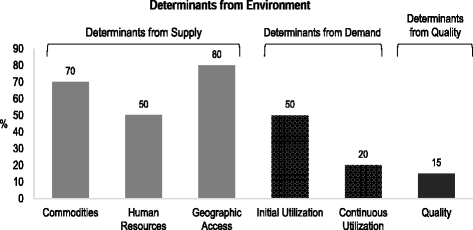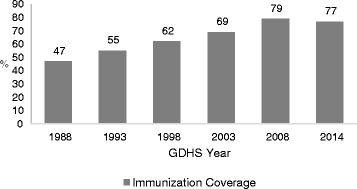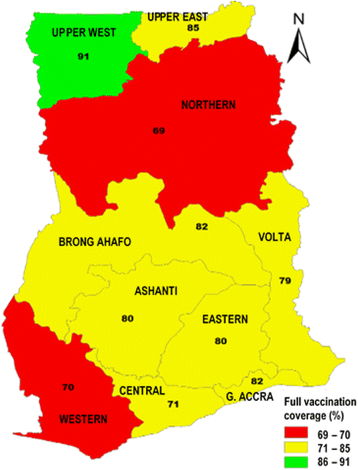Regional disparities in immunization services in Ghana through a bottleneck analysis approach: implications for sustaining national gains in immunization
- PMID: 28293422
- PMCID: PMC5346833
- DOI: 10.1186/s13690-017-0179-7
Regional disparities in immunization services in Ghana through a bottleneck analysis approach: implications for sustaining national gains in immunization
Abstract
Background: Immunization is considered one of the most cost effective public health interventions for reducing child morbidity, mortality and disability. The aim of this work is to describe the application of the Bottleneck analysis (BNA) process to assess gaps in immunization services in Ghana and implications for sustaining the gains in Immunization coverage.
Methods: A national assessment was conducted in May 2015, through use of desk reviews, field visits and key informant interviews. Quantitative data were analysed with the BNA Tool (an excel-based tool) based directly on service coverage data and programme monitoring and review reports in Ghana. Outputs were generated based on service coverage indicators; supply side/health system factors (commodities, human resource and access), demand side (service utilisation) and quality/effective coverage. National targets were used as benchmarks to assess gaps in coverage indicators.
Results: In all, only 50% of regions and districts had health facilities with at least 80% of health care workers training provided in-service training on routine immunization; only 40% of district had communities with functional fixed or outreach EPI service delivery point and over 70% of regions and districts had challenges with effective coverage of infants aged 0-11 months fully immunized during the past year. Other key health system bottlenecks included, limited number of fixed and outreach sites, difficult to reach island communities along the Volta Basin, inadequate storage facilities for vaccines at lower levels, stock out of vaccines and auto destruct syringes and absence of updated policies/field guides at services delivery points/facilities. In addition, inadequate in-service training in routine Immunization and absence of good quality data were major challenges. Demand side bottlenecks included fear of mothers on the safety of multiple vaccines and limited active involvement of communities in Immunization service delivery.
Conclusion: The BNA tool and approach provided data driven planning of health service in Ghana. This resulted in the development of regional and national operational plans for immunization and will be the baseline for evaluating the national programme in three years.
Keywords: Bottleneck analysis approach; Ghana; Health service scale up; Immunization.
Figures
Similar articles
-
Bottleneck analysis approach to accelerate newborn care services in two regions in Ghana: implications for national newborn care.Public Health. 2016 Dec;141:245-254. doi: 10.1016/j.puhe.2016.09.026. Epub 2016 Nov 4. Public Health. 2016. PMID: 27932010
-
Factors influencing attendance to immunization sessions for children in a rural district of Ghana.Acta Trop. 1997 Dec;68(3):259-67. doi: 10.1016/s0001-706x(97)00094-6. Acta Trop. 1997. PMID: 9492910
-
Reforming health service delivery at district level in Ghana: the perspective of a district medical officer.Health Policy Plan. 1999 Mar;14(1):59-69. doi: 10.1093/heapol/14.1.59. Health Policy Plan. 1999. PMID: 10351470
-
Health system barriers and levers in implementation of the Expanded Program on Immunization (EPI) in Pakistan: an evidence informed situation analysis.Public Health Rev. 2018 Sep 17;39:24. doi: 10.1186/s40985-018-0103-x. eCollection 2018. Public Health Rev. 2018. PMID: 30237907 Free PMC article. Review.
-
Integrated delivery of health services during outreach visits: a literature review of program experience through a routine immunization lens.J Infect Dis. 2012 Mar;205 Suppl 1(Suppl 1):S20-7. doi: 10.1093/infdis/jir771. J Infect Dis. 2012. PMID: 22315382 Free PMC article. Review.
Cited by
-
Factors Influencing Sustained Utilization of Child Welfare Services among Children Aged 18 to 59 Months in a Low-Income Rural Community, Ghana.ScientificWorldJournal. 2021 Mar 23;2021:1803946. doi: 10.1155/2021/1803946. eCollection 2021. ScientificWorldJournal. 2021. PMID: 33859541 Free PMC article.
-
Mapping of Pro-Equity Interventions Proposed by Immunisation Programs in Gavi Health Systems Strengthening Grants.Vaccines (Basel). 2023 Feb 2;11(2):341. doi: 10.3390/vaccines11020341. Vaccines (Basel). 2023. PMID: 36851218 Free PMC article.
-
Informal health sector and routine immunization: making the case for harnessing the potentials of patent medicine vendors for the big catch-up to reduce zero-dose children in sub-Saharan Africa.Front Public Health. 2024 Mar 7;12:1353902. doi: 10.3389/fpubh.2024.1353902. eCollection 2024. Front Public Health. 2024. PMID: 38515595 Free PMC article.
-
Effects of coronavirus pandemic on expanded program on immunization in weija gbawe municipality (Accra-Ghana).Hum Vaccin Immunother. 2022 Nov 30;18(6):2129830. doi: 10.1080/21645515.2022.2129830. Epub 2022 Oct 4. Hum Vaccin Immunother. 2022. PMID: 36194867 Free PMC article.
-
An assessment of Ghana's pilot of the RTS,S malaria vaccine implementation programme; 2019-2021: a retrospective study.Malar J. 2024 Sep 27;23(1):290. doi: 10.1186/s12936-024-05113-8. Malar J. 2024. PMID: 39334244 Free PMC article.
References
-
- Lawn JE, Kinney MV, Pfitzer A, Darmstadt GA, and Oot DA . A decade of change for newborn survival, policy, and programmes (2000-2010): A multi-country evaluation of progress towards scale. Health Policy and Plan. 2012;27(3). doi:10.1093/heapol/czs054.
-
- World Health Organization . Global vaccine action plan 2011-2020. Geneva, Switzerland: World Health Organization; 2012.
-
- Global Vaccine Alliance . Annual progress report. Switzerland, Geneva: GAVI; 2014. Saving Children’s lives and protecting People’s health by increasing access to immunization in poor countries.
-
- Keja K, Chan C, Hayden G, Henderson R. Expanded programme on immunization. World Health Stat Q. 1998;1(2):59–63. - PubMed
-
- Ghana Health Service . Annual report of the Ghana health service 2013, Accra, Ghana. 2014.
LinkOut - more resources
Full Text Sources
Other Literature Sources
Miscellaneous





